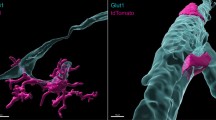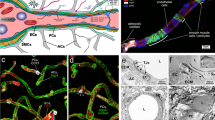Abstract
The blood-brain barrier (BBB) is composed of the brain capillaries, which are lined by endothelial cells displaying extremely tight intercellular junctions. Several attempts at creating anin vitro model of the BBB have been met with moderate success as brain capillary endothelial cells lose their barrier properties when isolated in cell culture. This may be due to a lack of recreation of thein vivo endothelial cellular environment in these models, including nearly constant contact with astrocyte foot processes. This work is motivated by the hypothesis that growing endothelial cells on one side of an ultra-thin, highly porous membrane and differentiating astrocyte or astrogliomal cells on the opposite side will lead to a higher degree of interaction between the two cell types and therefore to an improved model. Here we describe our initial efforts towards testing this hypothesis including a procedure for membrane fabrication and methods for culturing endothelial cells on these membranes. We have fabricated a 1 μm thick, 2.0 μm pore size, and ∼55% porous membrane with a very narrow pore size distribution from low-stress silicon nitride (SiN) utilizing techniques from the microelectronics industry. We have developed a base, acid, autoclave routine that prepares the membranes for cell culture both by cleaning residual fabrication chemicals from the surface and by increasing the hydrophilicity of the membranes (confirmed by contact angle measurements). Gelatin, fibronectin, and a 50/50 mixture of the two proteins were evaluated as potential basement membrane protein treatments prior to membrane cell seeding. All three treatments support adequate attachment and growth on the membranes compared to the control.
Similar content being viewed by others
References
Bauer, H.C. and H. Bauer (2000) Neural induction of the blood-brain barrier: Still an enigma.Cell. Mol. Neurobiol. 20: 13–28.
Stewart, P.A. and M.J. Wiley (1981) Developing nervous tissue induces formation of blood-brain barrier characteristics in invading endothelial cells: A study using quailchich transplantation chimeras.Dev. Biol. 84: 183–192.
Rubin, L. L. and J. M. Staddon (1999) The cell biology of the blood-brain barrier.Annu. Rev. Neurosci. 22: 11–28.
Gumbleton, M. and K. L. Audus (2001) Progress and limitations in the use ofin vitro cell cultures to serve as a permeability screen for the blood-brain barrier.J. Pharm. Sci. 90: 1681–1698.
Reinhardt, C. A. and S. M. Gloor (1997) Co-culture blood-brain barrier models and their use for pharmatoxicological screening.Toxicol. Vitr. 11: 513–518.
Gaillard, P. J., L. Voorwinden, J. Nielsen, A. Ivanov, R. Atsumi, H. Engman, C. Ringbom, A. de Boer, and D. Breimer (2001) Establishment and functional characterization of an in vitro model of the blood-brain barrier, comprising a co-culture of brain capillary endothelial cells and astrocytes.Eur. J. Pharm. Sci. 12: 215–222.
Rubin, L. L., D. E. Hall, S. Porter, K. Barbu, C. Cannon, H. C. Horner, M. Janatpour, C. W. Liaw, K. Manning, J. Morales, L. I. Tanner, K. J. Tomaselli, and F. Bard (1991) A cell culture model of the blood-brain barrier.J. Cell Biol. 115: 1725–1735.
Wolburg, H., J. Neuhaus, U. Kniesel, B. Kraub, E. Schmid, M. Ocalan, C. Farrell, and W. Risau (1997) Modulation of tight junction structure in blood-brain barrier endothelial cells.J. Cell Sci. 107: 1347–1357.
Hayashi, Y., M. Nomura, S. Yamagishi, S. Harada, J. Yamamshita, and H. Yamamoto (1997) Induction of various blood-brain barrier properties by close apposition to co-cultured astrocytes.Glia. 19: 13–26.
Kuiper, S., C. J. M. van Rijn, W. Nijdam, and M. C. Elwenspoek (1998) Development and applications of very high flux microfiltration membranes.J. Membr. Sci. 150: 1–8.
Muruganandam, A., L. Herx, R. Monette, J. Durkin, and D. Stanimirovic (1997) Development of immortialized human cerebromicrovascular endothelial cell line as an in vitro model of the human blood-brain barrier.FASEB J. 11: 1187–1197.
Giannouilis, C. S. and T. A. Desai (2000) Characterization of fibroblasts and proteins on thin films.Proceedings of SPIE Micro- and Nanotechnology for Biomedical and Environmental Applications. January 26–27. San Jose, CA USA.
MacDonald, D. E., B. Markovic, M. Allen, P. Somasundaran, and A. L. Boskey (1998) Surface analysis of human plasma fibronectin adsorbed to commercially pure titanium materials.J. Biomed. Mater. Res. A. 41: 120–130.
Tilling, T., D. Korte, D. Hoheisiel, and H. J. Galla (1998) Basement membrane proteins influence brain capillary endothelial barrier functionin vitro.J. Neurochem. 71: p. 1151–1157.
Ogura, E., B. Kusumoputro, and T. Moriizumi (1991) Passage time measurement of individual red blood cells through arrayed micropores on Si3N4 membrane.J. Biomed. Eng. 13: 503–506.
Author information
Authors and Affiliations
Corresponding author
Rights and permissions
About this article
Cite this article
Harris, S.G., Shuler, M.L. Growth of endothelial cells on microfabricated silicon nitride membranes for anin vitro model of the blood-brain barrier. Biotechnol. Bioprocess Eng. 8, 246–251 (2003). https://doi.org/10.1007/BF02942273
Received:
Accepted:
Issue Date:
DOI: https://doi.org/10.1007/BF02942273




